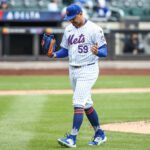
Whit Merrifield
Position: 2B/OF
Bats/Throws: R/R
Age: January 24, 1989 (29)
Traditional Stats: .304/.367/.438, 43 2B, 3 3B, 12 HR, 60 RBI, 45 SB, 10 CS
Advanced Stats: 5.5 bWAR, 5.2 fWAR, 121 OPS+, 120 wRC+
Second Base Defensive Stats: 8 DRS, 1.1 UZR
Center Field Defensive Stats: 2 DRS, 4.0 UZR
Arbitration Eligible: 2020
Free Agent: 2023
Not too dissimilar from what the Mets saw with Jeff McNeil last year, Merrifield was a late-round draft pick, who would eventually force his way to the Major Leagues. Since cracking into the majors in 2016, Merrifield would improve his batting average, OBP, and slugging in each of his three Major League seasons.
Unfortunately for Merrifield, his improvement has had an inverse correlation with the Royals record. In fact, while Merrifield has been making himself an All-Star caliber player, the Royals have gone from a .500 ballclub to a 104 loss team.
With how poorly the team performed last season, they found themselves sellers. Jon Jay was traded to the Diamondbacks. Kelvin Herrera was traded to the Nationals. Drew Butera was traded to the Rockies. The team would also sell off Terrance Gore and Lucas Duda. From a standpoint on how it affected the fans psyche, nothing was more impactful than the team trading Mike Moustakas to the Brewers.
What is interesting is through all of these trades, the Royals are at least publicly saying they are not rebuilding. On the topic, Royals GM Dayton Moore would say, “I feel like there won’t be a lot of turnover, a lot of change, a lot of adding to that group. We’re prepared to go forward with them.” (Sam McDowell, Kansas City Star).
While this does not indicate a rebuild is underway, Moore did also say the Royals need to get their budget under control and move some prospects. In essence, he’s saying the Royals are rebuilding without saying it. With that being the case, it is time for the organization to decide who is and who is not part of the future.
With respect to Merrifield, the Royals have continued to insist they are not trading him. Considering he is under team control through 2023, this makes a lot of sense. However, it should be noted that by then Merrifield will be 34 years old. This means chances are Merrifield will no longer be a significant part of this Royals team when they are ready to contend again.
Trading Merrifield is all the more difficult when you consider he’s a fan favorite, and the fact he wants to be a Royal. In fact, Merrifield would tell Rustin Dodd of The Athletic that he wants to not just stay a Royal, but he also wants to sign an extension with them. Of course, given his age, his free agency being so far away, and the Royals wanting to get the payroll under control, an extension is not going to happen anytime soon.
Realistically speaking, the Royals need to trade Merrifield now as his value will likely never be higher. After all, if you dig through the numbers, Merrifield had a .349 BABIP while having just an average 8.6 percent walk rate.
Why the Mets Should Obtain Him
With McNeil, if the Mets are not set at second base, they have a player who should enter the season as the odds-on favorite to be the Opening Day second baseman. Even with the team needing a right-handed bat, you would be hard-pressed to argue Merrifield would definitively be better than McNeil. With that being the case, there is no way you give up assets for Merrifield.
However, that overlooks the Mets need for a center fielder, and as we saw last season, Merrifield was capable of playing center field. In 241.2 innings in center last season, Merrifield had a 2 DRS and 4.0 UZR. While these stats are from a far too small sample size, they are indicative of his ability to play center.
Certainly, Merrifield has the skill set to succeed in center. Baseball Savant has Merrifield’s sprint speed at 29 feet/second. That puts him ahead of Gold Glove-caliber center fielders like Lorenzo Cain, Kevin Kiermaier, and Jackie Bradley Jr.
Not only does Merrifield’s speed allow him to cover ground in center, it allows him to wreak havoc on the basepaths. Certainly, it would be enticing to put him atop the lineup with Brandon Nimmo to set the table for the rest of the order. It also can’t hurt to have another right-handed bat in a lineup which struggles against left-handed pitching.
Why the Mets Should Not Obtain Him
As noted, Merrifield is a prime regression candidate. Worse yet, he going to be an expensive one as the Royals not only do not have to move him, but they also do not feel inclined to move him. In these situations, you typically have to pay a bit of a premium. Considering how you would likely have to play him out of position, it would not be a prudent decision to make that trade.
Verdict
If Merrifield was the last piece the Mets needed to be a contender, you absolutely go forward and make the deal. With his speed and his ability to put the ball in play could change the offensive outlook for a Mets team which strikes out far too often. After all, as a team, the Mets struck out 22.7 percent of the time last year.
However, the Mets are not one piece away, and even if they were, that piece is not Merrifield. It is better to hold onto your assets and circle back to Merrifield or other options at the trade deadline.














